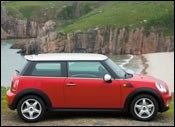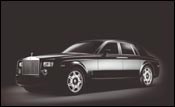Automotive Finishing: Flex, Phantoms & Beyond
Whether it’s the Ford Flex or the Rolls-Royce Phantom, finish is key to customer acceptability
One of the most significant vehicle introductions of 2008 is the 2009 Ford Flex. This crossover vehicle—meaning it’s a vehicle that’s based on a car platform (in this case the same one that’s used for the Taurus and Sable) stretched five inches to accommodate three rows of seating—is certainly distinctive in its overall geometric shape.
Or let’s call it what it is: boxy.
But there’s something else about a number of the Flex vehicles that will help them stand out from most all the rest: the paint scheme.
As Rich Gressens, the man who designed the Flex exterior, explains, “The all-black greenhouse allowed us to do the complementing color roof. If we had body-colored pillars and clear glass, it would have been difficult to do, but it all ties in together.”
The customer can select either a “White Suede” or a “Brilliant Silver” roof color. So one might opt for a Redfire or Dark Ink Blue or Light Ice Blue body color and a White Suede top. (While the names of paints tend to be a bit exaggerated, one of the most unusual has to be the name of a paint that was specifically developed for the Mazda Taiki concept vehicle: “Ozonic Silver.” You can almost smell it.)
Going to Oxford
Arguably, the vehicle that started the contemporary two-tone trend is the similarly geometric MINI. The MINI body is produced in a plant in Oxford, England. The plant actually goes back to the 1930s, when the Morris Motor Car company produced vehicles there. BMW Group (which owns MINI) purchased the Oxford plant in 1994. It did a wholesale upgrade of the facility for the first generation of its MINI, then invested an additional £100 million starting in 2005 to prepare for this second-generation of vehicles. A large part of this additional money was spent on increasing the production capacity to 240,000 units/yr and to build a second paint shop in the plant.
One interesting aspect of the MINI paint facility is that one might imagine the most-advanced system would be in place for say, the other “British” brand that’s part of the BMW Group: Rolls-Royce. But as it turns out, BMW decided that it would install its first Integrated Painting Process (IPP) within the Oxford plant. IPP is an approach wherein the rust proofing and primer are applied together with the first layer of paint, then cured. This combination of operations saves materials, time and energy.
A Majestic Approach
However, it’s not like Rolls-Royce was left begging when it comes to its finishing operations. Rolls-Royce headquarters and production operations were established at Goodwood in West Sussex; production operations for the Phantom model commenced in August 2002. As befitting Rolls-Royce, the paint shop is not called the “Paint Shop.” Rather, it is the “Surface Finish Centre.”
In the Surface Finish Centre, aluminum space frames are pretreated for corrosion protection and to assure that paint will adhere to the metal. The body is cleaned, then goes into a clean room for painting. A water-base primer, a color base coat, and two clear coats are applied. Both robots and workers are used for the painting—or surface finishing—operations. In fact, the only place in the Goodwood facility that robots can be found are in the paint shop.
During the paint process, after each coat is applied it is oven-cured and then hand sanded before the next coat. And, as this is a Rolls-Royce, about five hours of hand polishing are performed after painting to assure there is appropriate gloss finish.
Unlike, say, a Ford Flex or even a MINI Clubman, vehicles are built to customer specifications. After all, these are hand-built, not mass-produced, motor cars.
There is a standard pallette of 18 colors on offer. However, because this is Rolls, and because Rolls has, well, demanding and discerning customers, the full scale of the paint pallette includes 45,000 colors.
Two-tone cars can be selected. As can “horizontal coach lines”—think pinstripes. These take three hours to execute. Interestingly, Rolls is increasing its production as it is adding a second offering to its lineup, this based on the two-door, four-seat 101EX concept. This has necessitated expansion of the paint facilities, including new handling equipment and paint applicators. There are two assembly lines in the plant, one for the Phantom and the second for the new coupe.
And even though this is Rolls, they are not insensitive to environmental concerns. For example, the heat generated by the gas burners in the ovens eliminates the need for water heating for the paint booths. The water system is closed. Moisture evaporating from the water-based paint is condensed and then rerouted into the system. Yes, small details matter.
Get Small
And speaking of small, it brings us back to Ford. But in this case, really small: as in 1×10−9. According to Matthew Zaluzec, manager of the Materials Science and Nanotechnology Dept., Ford Research and Advanced Engineering, they’re working with nanomaterials to help improve the adhesion, durability, and appearance of paints. As he put it, “We want to take paint beyond what our customers are used to seeing on a vehicle. We constantly ask questions like, ‘Can I change the functionality of a paint layer to give a unique appearance, to control heat dissipation, or improve durability beyond what we’ve achieved to date?’”
Perhaps, before too long, Light Ice Blue will actually be more than the name of a color on a car. Maybe it will actually have thermal properties.
Related Content
Intumescent Coating Provides Up to 3 Hours of Fire Protection
PPG Steelguard 951 coating is designed to provide protection against fire and corrosion.
Read MoreMasking Solutions Provider CFS Dramatically Expands Capabilities and Capacity
Custom Fabrication & Supplies (CFS) completed a new plant expansion packing 10 times the capacity into twice the space. It dramatically enhances the supplier’s custom capabilities to provide extremely precise and cost-effective masking solutions.
Read MoreHenry Ford Is Still Right When It Comes to Color
Who would have imagined that more than 100 years after his famous statement about any color as long as it’s black would still have relevance of a sort?
Read MoreShedding Light on Surface Inspection
State-of-the-art reflector-based lighting system improves luminosity and ergonomics for surface inspection tasks while reducing energy usage.
Read MoreRead Next
Education Bringing Cleaning to Machining
Debuting new speakers and cleaning technology content during this half-day workshop co-located with IMTS 2024.
Read MoreEpisode 45: An Interview with Chandler Mancuso, MacDermid Envio Solutions
Chandler Mancuso, technical director with MacDermid Envio discusses updating your wastewater treatment system and implementing materials recycling solutions to increase efficiencies, control costs and reduce environmental impact.
Read MoreA ‘Clean’ Agenda Offers Unique Presentations in Chicago
The 2024 Parts Cleaning Conference, co-located with the International Manufacturing Technology Show, includes presentations by several speakers who are new to the conference and topics that have not been covered in past editions of this event.
Read More
.jpg;width=70;height=70;mode=crop)

















.jpg;maxWidth=300;quality=90)







